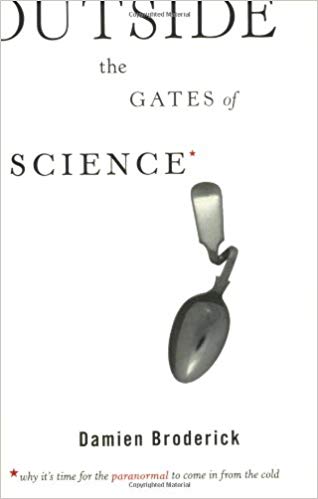Outside the Gates of Science: Why It’s Time for ESP to Come in From the Cold, By Damien Broderick
(New York: Thunder’s Mouth Press (Avalon), 2007. 368 pp. + index)
I had been hearing about Outside the Gates of Science for some time when I finally ordered it. It sat on my shelf for months while I waded through brain-shredding volumes of philosophy and science papers crucial to my dissertation. And then it came time to move into the subject matter that Outside the Gates of Science centers on – a direct argument for why and how extrasensory perception (ESP) fits into the scientific world, and why it has so long been excluded. So I dusted off the cover and set to work.
And what an informative and thought-provoking experience it was! The book tells of Australian science and science fiction writer and critic Damien Broderick’s own journey through the world of ESP (or psi for the more general term) research. Though he admits to having explored a small chunk of the topic before, he approaches the larger field of parapsychology with a bit of a skeptical edge, almost as if he is daring the subject matter — the evidence, the sometimes rather astonishing results — to persuade him against his will. It’s almost as if it is not just psi, but also he himself for whom it is time to come in out of the cold — to arrive at a fuller realization of how much substance there really is to these claims about exceptional human abilities that the scientific world finds so unacceptable.
At times Broderick verges on indignation that ESP continues to be suppressed by mainstream science and its skeptic guard dogs in the face of all that has been discovered about it. Yet his prose shows a grudging reluctance to let go of previous doubts — a reluctance to just bust loose and embrace the wildness.
But that in itself is the charm and the value of the book. If someone this reluctant to fully absorb the idea that there must be something real going on with psi can find himself being convinced by the mounting evidence which he entertainingly but carefully describes, then by golly the scientists had better listen. But the most skeptical among them will likely not listen, but instead run headlong away instead. If Damien Broderick has become a convert, they themselves could easily be next.
There is a sequel to the story. Among the pages of the book I discovered an interesting fact – Damien Broderick lives a mere hour and half from me! At some point in his mercurial career he had met and married an American lawyer and settled here in Texas with her. I reached out…and found a new friend. As I made my way up the front porch a few weeks later, I entered a sensorily rich realm no less fascinating than it was mind-expanding.
Damien’s domain is a nearly century-old house run amok with hardwood floors, high ceilings, banisters, and wainscoting. But the dwelling is now in the throws of a decade-long renovation program, and so is strewn with construction materials and tools as, one room at a time, it is being transformed from musty elegance to up-dated comfort. As we sat together around his kitchen table amidst the detritus of architectural rebirth, he alternately expounded, questioned, and challenged, weaving a tangled conversational trail through philosophy, culture, and science, all tied together with a thread of ESP and remote viewing.
The holder of a Ph.D. in literary studies (his dissertation is about “the comparative semiotics of scientific, literary and science fictional textuality”), the man is nothing if not erudite. And his intellect runs to the far corners of the world, from evolutionary theory and literary archetypes to how best to use ESP to win the lottery. I have no idea how long our conversation lasted. All I know is that as I took my leave in the midst of a rare chilly Texas rain storm, I was drained but exhilarated and taking with me a much richer appreciation for the book this amazing man had produced. I highly recommend you read it.
(A version of this review appeared in Aperture, Vol. 4, No. 4, (Issue 16) 2009)
